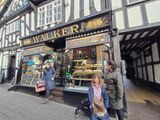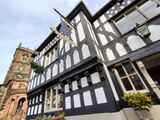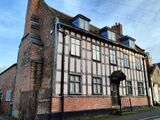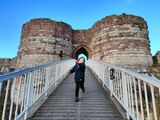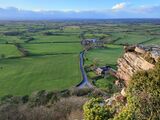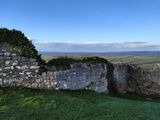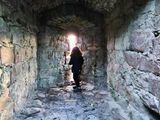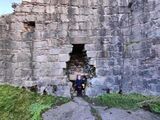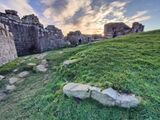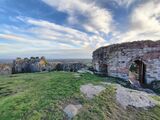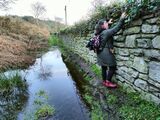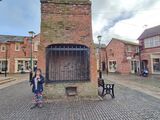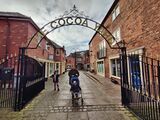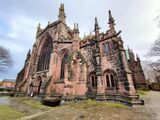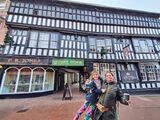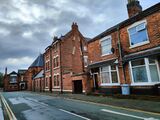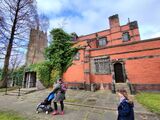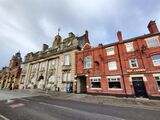Whitchurch, Beeston castle, Nantwich, Crewe and Sandbach (January 2023)
A campervan one-night (no heater) trip on the border of Shropshire.
Whitchurch

Whitchurch is the oldest continuously inhabited town in Shropshire at the border of Wales and Cheshire. It had several names, starting with the beautiful one of Mediolanum—middle of the plain—in Roman times. Its current denomination stems from Middle English for "White Church", referring to a white stone church constructed in the Norman period. It still has many, indeed around 100 listed, buildings of interest. Sir John Talbot, the most famous English military man from the Hundred Years' War, of Shakespeare fame (cf. Henry VI, Part I), known as the terror of the French, is buried there. He is also famous for an eponymous dog. We visited the place on 14 January (2023).
-
The main street.
-
A typical building of special interest.
-
Another one, still functionning as a shop with a happy local patron .
-
St Alkmund by the Black bear, where we had our lunch.
-
The inscription by the porch mentionning Sir Talbot's heart is buried below.
-
One of the numerous listed buildings, this time farther from the centre.
Beeston castle

Beeston castle, built 1220s by an Earl of Chester on his return from the Crusades, is highly perched on a rocky sandstone, offering a beautiful view on the Cheshire plain, from the Wrekin to Liverpool. Once a royal castle, it is believed Richard II of England's treasure is hiding somewhere around. Henry III used it as a prison for Welsh during his war with them. There is also a reconstructed roundhouse from the Bronze Age, built using authentic tools. There you learn for instance that people inside were not using chimney, with the smoke trapped at the top killing rodents and preventing fire by exhausting oxygen. We visited the site on 14 January (2023).
-
The modern bridge one needs to access the highly perched castle.
-
The Cheshire plain, below.
-
Looking flat at the top.
-
Julia balancing herself in the strong winds at the top.
-
Going through a thick window.
-
Luz making it through to the other side.
-
Now in a hole in the wall.
-
A vantage point to marvel at the sunset over the Cheshire plain.
-
The colors of Cheshire if you ask us: green and blue.
-
An appearance of continuity, with over 100m of free fall between this green and that one beyond the walls.
-
Trying to go round, back at the bottom.
Nantwich

Nantwich is a jewel of Cheshire, counting among the highest concentrations of listed buildings in England. We could not visit properly the church, for which we initially came, because a service was being held, that I started to attend with Julia. We visited on 15 January (2023).
-
A giant opened chimney in the cocoa yard.
-
Luz loudly complaining that she's the only one without a cocoa.
-
St Mary's Church is an important 14th-century church.
-
Only Chester, which is much bigger, has more buildings of this type in the county.
-
The crown hotel is another jewel of Nantwich, with peculiar, unique features (such as the upper row of windows).
-
By a funny door which had to adapt itself to medieval distortions.
Crewe

Crewe is a so-called railway town and its main claim to fame is probabably as a recurrent final destination from many lines advertised in train stations. It is remarkable as probably the least attractive city in the UK. It is, basically, a gigantic train station. It was, in fact, difficult to find out what was supposedly the city centre. The only notable building, the Crewe hall, is far from Crewe itself. We found a demolished church (Christchurch) whose current office as a garden and memorial was closed, and the Crewe municipal buildings that are flanked by a pretty but closed pub, and a refurbished market. Nearby is the Lyceum theatre, which is treasured by local for the much needed entertainment it provides.
-
Crewe is not that bad, after all, but it doesn't get much better than this random street.
-
Christ church.
-
That is both destroyed and closed (the photo is from outside the fence).
-
Crewe's highlight: the municipal buildings. The market on the left is operating.
-
Inside the market.
-
With the nearby Lyceum theatre.
Sandbach

Sandbach is a pretty Cheshire town, famous for its 9th-century Saxon crosses, in the cobbled square, carving in stone imageries from the life of Christ. Some theories date them to as back as 653. A local from 1585, with centuries on both sides, described them as "two square crosses of stone, on steps, with certain images and writings thereon graven [standing] hard together". The fact that you would expect to find them in the British museum while they lay, naked, in the open square, makes for a moving encounter.
-
Julia by the town hall.
-
Elena approaching the Saxon crosses.
-
The Saxon crosses, a jewel of Mercia.
-
In the church.
-
Interesting and peculiar inscriptions in the choir.
-
A street in Sandbach.


